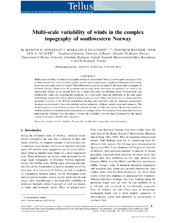Multi-scale variability of winds in the complex topography of southwestern Norway
Peer reviewed, Journal article
Published version

Åpne
Permanent lenke
https://hdl.handle.net/1956/12089Utgivelsesdato
2012-01-02Metadata
Vis full innførselSamlinger
- Geophysical Institute [1187]
Originalversjon
https://doi.org/10.3402/tellusa.v64i0.11962Sammendrag
Multi-scale variability of winds in the complex terrain of southwestern Norway is investigated using up to 20yr of observations from nine automatic weather stations and reanalysis data. Significant differences between the large- and local-scale winds are found. These differences are mainly governed by the large-scale topography of Southern Norway. Winds from the southeast and statically stable flow from the northwest are found to be significantly reduced at the ground level due to large-scale wake and blocking effects. Southwesterly and northeasterly winds are orographically enhanced. At a local scale, there are differences in the wind speed distributions between the surface stations, both in space and time. These differences can to a large extent be quantified in terms of the Weibull distribution function and associated with the respective geographical locations as discretised in four characteristic surface categories: offshore, inland, coast and mountain. The inland category is found to be associated with relatively low but variable wind speeds, whereas the coastal and offshore locations are dominated by more steady and stronger winds. The mountain wind speed distribution is fundamentally different from the others; it shares the variability with the inland locations but the higher average wind speed with the other categories.
